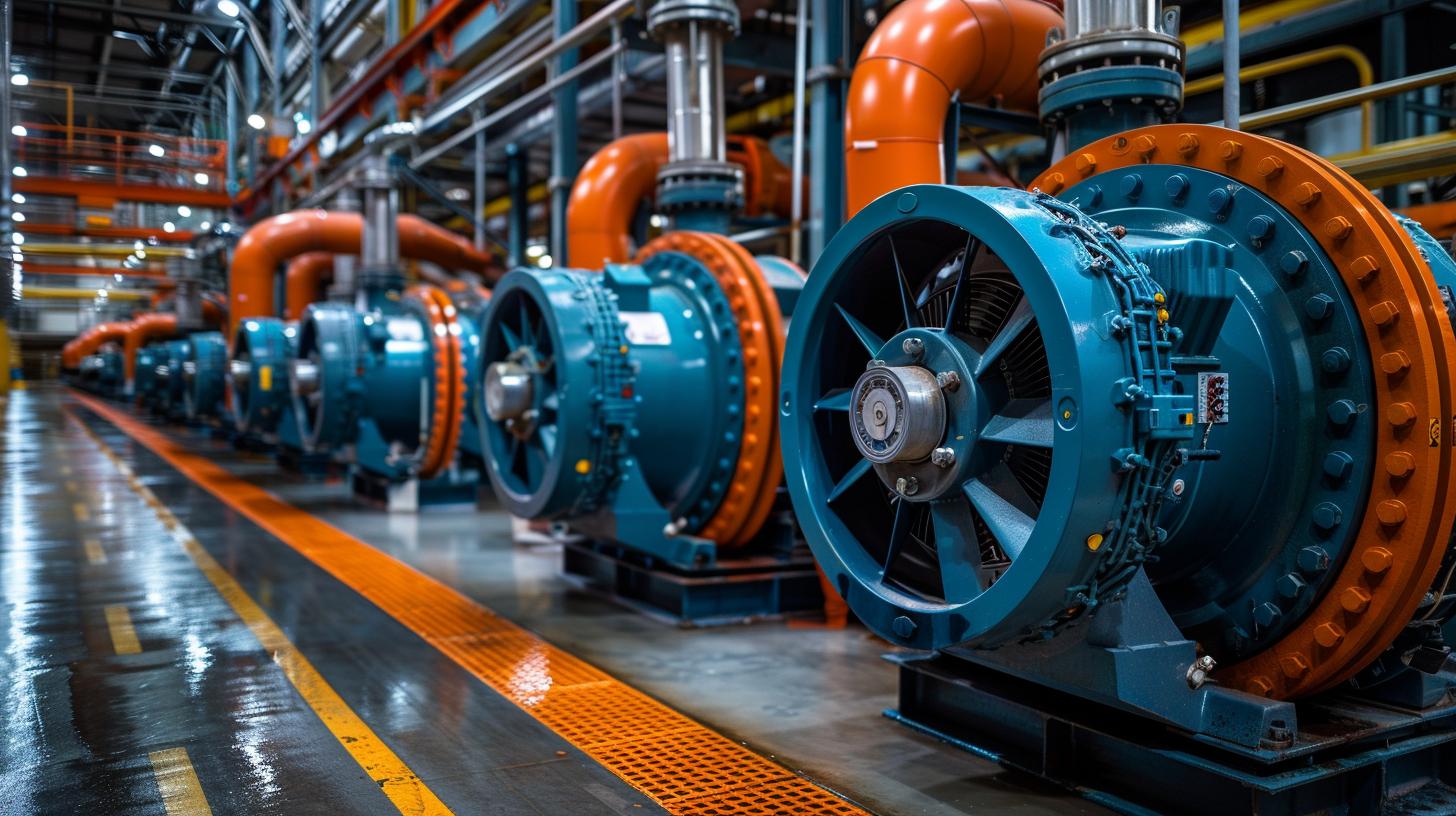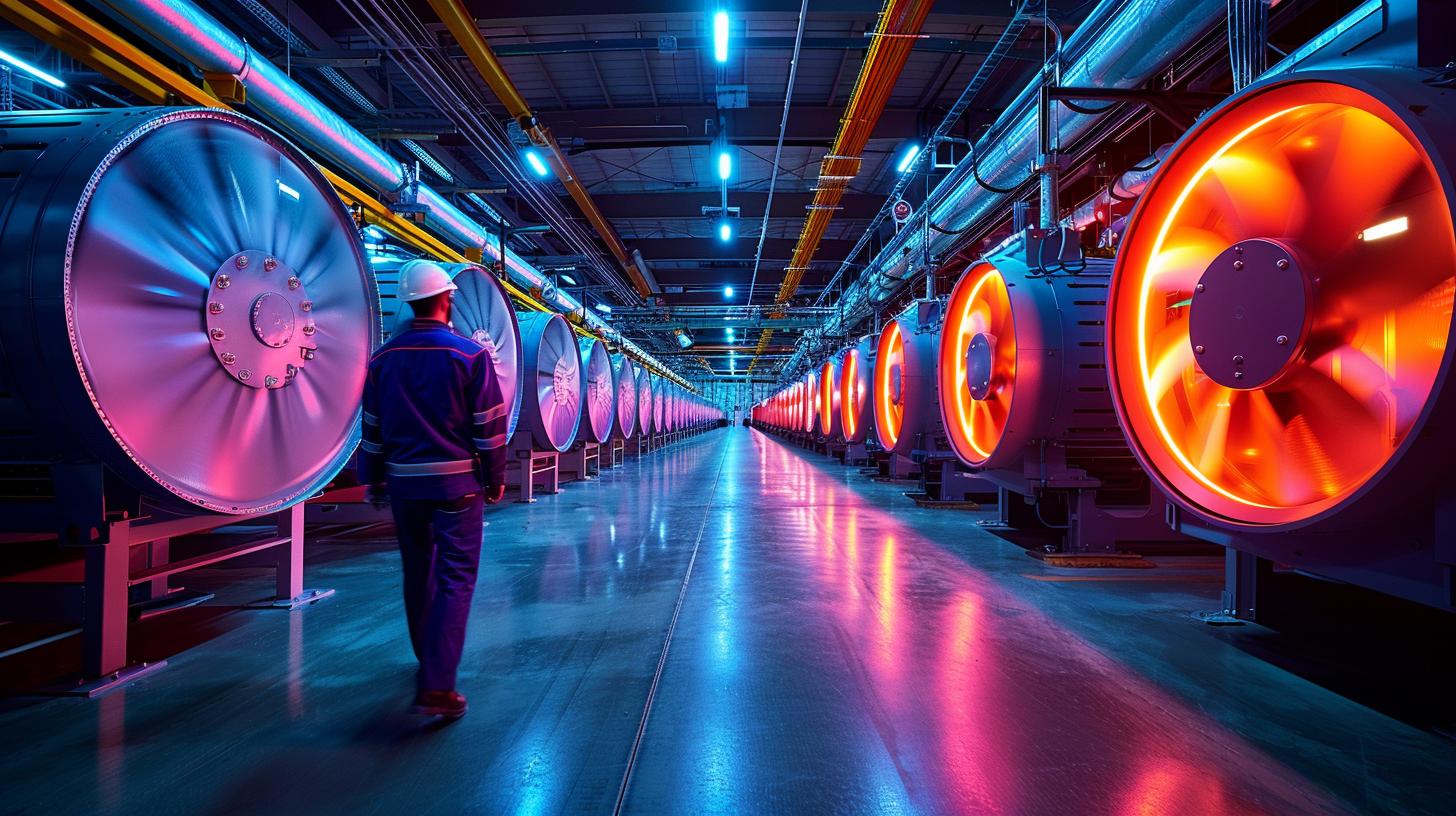As a facilitator of Bitcoin mining, the subject of a scalable bitcoin mining infrastructure is rapidly earning widespread momentum. Scaling up an operation obliges not only the incorporation of more advanced hardware but also the improvement and augmenting the very framework that supports such operations. This introductory section will delve into explaining what a scalable Bitcoin mining infrastructure entails and why it’s critical in facilitating advancing operations.
At its heart, a scalable Bitcoin mining infrastructure is an adaptive system designed to cope with increased operational load. Unlike standard systems, which can often struggle under increased demands or require significant resources for updates, scalable infrastructures are designed to ‘scale up’ with ease.
They do this by adding new components or improving existing ones to maintain operational efficiency while increasing capacity. Mining bitcoins require a high degree of processing power and energy consumption; growing these factors without impacting performance necessitates having an adaptable infrastructure.
This scalability factor is pivotal within the context of growing operations since it allows handlers to incrementally bolster their mining capacities without inducing detrimental side effects on performance. Scalable Bitcoin mining infrastructures promote efficiency, keep costs predictable as one scales up, and ensure more reliable income via steered hash rates or mined Bitcoins. Ultimately these characteristics not only contribute towards heightening profitability and reducing wastage but also provide stability amid market fluctuations.
By comprehending this foundation level insight about scalable bitcoin mining infrastructure, operators could better equip themselves for sustainable expansion in this entrepreneurial landscape peppered with opportunities aplenty and formidable challenges alike. As we dive deeper into this article continuously equipping you on your journey into leveraging this powerful tool to your utmost benefit.
Understanding the Bitcoin Mining Ecosystem
The Evolution of the Bitcoin Mining Landscape
The emergence of Bitcoin as a decentralized digital currency marked the genesis of bitcoin mining and its associated infrastructure. Originally, anyone with a computer could mine Bitcoins but as more miners joined the network, the difficulty level increased.
This evolution necessitated more computational power and energy, leading to a shift from casual mining on personal computers to data center-like environments filled with cutting-edge hardware dedicated solely towards mining. Over time, specialized ASIC (Application-Specific Integrated Circuit) miners were introduced which significantly boosted the hashing power and mining efficiency.
Scalable bitcoin mining infrastructure evolved as part of this landscape transformation as operations grew beyond home-based setups to elaborate multi-node operations. Businesses quickly realized that for sustainable growth and profitability in an increasingly competitive sphere, there was a need for scalable solutions capable of managing increasing computational loads in an efficient manner.
Fundamentals of Bitcoin Mining
Bitcoin mining is essentially the process of verifying transactions within the Bitcoin network which involves solving complex cryptographic puzzles. A successful solution results in a miner being awarded some Bitcoin in return for their effort – this is known as block reward. Key steps include collection of new transactions into a block, proof-of-work (solving mathematical problems), and adding verified transaction blocks back into public blockchain ledger.
Infrastructure plays a critical role at every stage in this process – it collects new transactions from network nodes, provides computing power to solve complex puzzles (“proof-of-work”), maintains synchronization with other nodes in real-time and helps add verified blocks back onto public ledger. All these massive tasks demand robust infrastructure capable of handling high volume computations while maintaining high efficiency levels.
Role of Infrastructure in Bitcoin Mining
A robust infrastructure forms the backbone against which all bitcoin mining activities are conducted and hence, directly impacts operational performance and profitability. Necessary facets include not just physical hardware units like servers or ASIC chips that offer hashing power, but also incorporated software tools for mining pool management, network synchronization and transaction verification.
Other key elements include a reliable power supply to keep the equipment running and effective cooling systems to prevent overheating, which is a prevalent issue in this high-load operational environment.
As mining operations grow, these infrastructure needs enlarge exponentially. Managing this growth effectively requires implementing scalable bitcoin mining infrastructure that can dynamically adjust according to operational demands and optimize the use of available resources. This allows operations to maintain peak performance levels while reducing associated costs and risks, paving the way for long-term growth in an intensely competition-driven landscape.

The Key Components of a Scalable Bitcoin Mining Infrastructure
With success in bitcoin mining heavily dependent on how efficiently miners can run their operations, sustainable and scalable bitcoin mining infrastructure becomes key. Certain fundamental components form the backbone of such an infrastructure, both physical and digital. These range from actual hardware to the underlying software systems, all playing crucial roles in sustaining a scalable mining ecosystem.
Physical components primarily include:
1. Mining Hardware: Rigorous choice of high-performance hardware is critical to expand mining capabilities.
2. Efficient Cooling Systems: With heat generation being a significant concern for large-scale miners, efficient cooling solutions are vital.
3. Energy Supply: A stable and continuous energy supply is a must-have for any sizeable operation as it directly impacts performance and profitability.
On the other hand, digital aspects provide the conduit through which these physical elements interact cohesively to deliver functionally efficient systems.
- Data Centers: Deploying specialized high-capacity data centers provides miners with enhanced management of its resources.
- Network Infrastructure: A strong network system ensures smooth communication between various parts of your mining operation.
Without forgetting:
– Quality Software: Specialized mining software allows complex mathematical problems required for BTC transactions to be solved efficiently.
– Robust Security Systems: To protect from threats like hacking attacks, incorporating state-of-the-art security solutions will be critical.
– Maintenance & Monitoring Tools: A suite of tools enables real-time monitoring and prompt maintenance in case of issues that can prevent downtime or losses.
Striking a balance between these various facets creates synergy that unlocks immense value for bitcoin miners enabling overall scalability and sustainability over time.
Data AirFlow allows individuals and organizations achieving this balance by building customizable options that integrate seamlessly into existing frameworks. This flexible approach enables an ideal blend that utilizes already-installed capabilities while infusing new modules that elevate performance levels to desired standards. The perfect combination of these components significantly impacts operational efficiency, leading to higher profits for miners. That’s why considered investment in a scalable bitcoin mining infrastructure is critical for any serious player in the bitcoin mining space.
Data AirFlow’s Approach to Scalable Bitcoin Mining Infrastructure
Data AirFlow has understood that achieving a scalable bitcoin mining infrastructure entails unifying both physical hardware and digital software aspects in an efficient manner. Over the years, they have honed their approach to designing and delivering effective solutions that support growing operations in this energy-intensive field.
At the heart of Data AirFlow’s solution is cutting-edge mining technology combined with flexible, energy-efficient setups. The focus here is geared towards providing secure, decentralized processing power. Their systems utilize advanced ASIC (Application-Specific Integrated Circuit) miners renowned for their efficiency and computational power. Alongside these physical components, Data AirFlow also emphasizes optimization of software configurations to maximize performance and maintain stability, even under peak loads.
In addition to the computational elements, Data AirFlow takes into consideration factors such as location-specific conditions to ensure optimal performance. Understanding that costs associated with cooling or heating can dramatically affect profits, they strive to provide locations with ambient temperatures favourable for mining operations. Furthermore, recognizing the importance of supportive regulatory frameworks in different territories, Data AirFlow assists its clients in identifying jurisdictions where crypto mining is welcomed or at least not treated as illegal.
Accompanying these robust solutions with expert guidance ensures that customers can depend on Data AirFlow when it comes to scalable Bitcoin mining infrastructure.
| Factors | How It Contributes to Scalablity |
|---|---|
| ASIC Miners | Provides efficient and enhanced computational power. |
| Software Configurations | Optimizes performance and maintains stability under challenging loads. |
| Ambient Temperatures | Saves cost on cooling/heating systems while enhancing overall operation. |
| Regulation Frameworks | Promotes operation within a legal and supportive territory. |
Implementing Scalable Infrastructure for Your Bitcoin Mining Operations
Step 1: Initial Planning
The initial planning phase is crucial when implementing a scalable bitcoin mining infrastructure. This process starts with setting your long and short-term goals, defining your budget, and carefully considering the technical requirements of your operations. It’s also beneficial to keep in mind the potential growth of your operation which will be significant if you anticipate scaling up in future.

In terms of hardware considerations, it’s crucial to select highly efficient miners that can handle increasing workloads as you grow. Other considerations include cybersecurity measures, server redundancy, backup systems, and power usage effectiveness (PUE) monitoring. For network management, consider solutions that can support remote supervision and diagnosing of issues – these facilities are essential for maintaining an operation on a large scale.
Step 2: Setup
Once the planning phase is out of the way, it’s time to set up the infrastructure. Set up involves installing and configuring appropriate hardware and software related to bitcoin mining such as routers, servers, security systems among others. At this stage, it is possible to install any customisations you might have specified for your scalable bitcoin mining infrastructure.
After setting up the physical requirements, procedures should then be put into place in relation with data management including data storage answers for mined data blocks and transaction records. A cool environment is required for optmial performance since minors tend to heat up quickly hence heating ventilation air conditioning system (HVAC) come into play which should also be considered while doing setup.
Step 3: Maintenance & Scaling Up
Following setup, maintenance becomes an ongoing priority to ensure smooth operation without any hitches that could cause disruptions or loss of data. Regular checks on function equipment ought to be carried out from temperature controls upto cybersecurity measures all need regular updates so as not to compromise system integrity and functionality.
When preparing to scale-up operations activities like adding new miners or expanding server capacity are carried out. Other activities include onboarding of new personnel who will be manning the increased operations as more are added. When set infrastructure is well maintained, it’s becomes easier to scale and add new hardware or software hence making transitions seamless.
Case Study
In order to fully understand the importance and efficacy of a scalable bitcoin mining infrastructure, we should consider its application in practical, real-world scenarios. Let’s explore how an up-and-coming cryptocurrency mining operation successfully utilized Data AirFlow’s responsive solutions.
This particular organization, which we’ll refer to as CryptoCorp, had a moderate but rapidly growing Bitcoin mining operation. Initially, their setup consisted of a handful of ASIC miners that sat on makeshift racks in a converted office space. Their infrastructure was rudimentary and incapable of significant expansion. However, the upward trend in Bitcoin’s value spurred them to scale up their operations swiftly to capitalize on their investment.
To address this need for scalability while maintaining efficiency and control over costs, CryptoCorp turned to Data AirFlow’s end-to-end scalable bitcoin mining infrastructure solutions. The transformation was substantial and involved deploying modular high-density data centers effectively designed for cryptocurrency mining operations. These units are incredibly energy-efficient and ensure optimal cooling conditions for the advanced hardware they contain.
More so, the implementation of automated management software by Data AirFlow ensured efficient oversight across all facets of the operation including miner performance tracking, remote miner rebooting functionality, system health diagnostics tools among other salient features.
| Before Implementation | After Implementation |
|---|---|
| Small scale operation with limited capacity | Large scale operation with high-level expandability |
| Inefficient energy usage due to poor setup | Optimized energy use through high-efficiency data centers |
| Limited control and oversight over individual miners | Comprehensive operational monitoring & speedy resolution of issues via advanced management software. |
As illustrated in this case study, CryptoCorp was able to make a successful transition from a rudimentary operation to a scalable and efficient mining setup. The importance of this transformation cannot be overstated given the dynamic nature and high competitiveness in Bitcoin mining. Investing in a scalable bitcoin mining infrastructure set CryptoCorp on a path for sustainable growth, ultimately fortifying their ability to remain significant players within the cryptocurrency landscape.
Conclusion
As we wrap up our dissection of the scalable bitcoin mining infrastructure, it becomes clear that this setup lays the foundation for future growth and success of any serious bitcoin mining endeavor. With a constantly evolving landscape, having infrastructure capable of scaling up or down with the needs of operations is crucial when striving to maintain competitive advantage.

Integrity, reliability, and flexibility are inherent characteristics of scalable infrastructures, reinforcing their importance to modern-day miners and institutions involved in the cryptocurrency space.
Looking towards the future, as technologies continue to improve and become even more efficient, scalable bitcoin mining infrastructure will also evolve. For example, we can anticipate advancements in cooling technology which would allow more efficient heat management within large-scale operations. This would have a direct impact on profitability by reducing electricity costs associated with cooling equipment.
Similarly, emerging technologies such as Artificial Intelligence (AI) could be employed to manage these infrastructures more effectively. Imagine AI-powered systems monitoring mining rigs around the clock for optimal performance while predicting and scheduling maintenance before any malfunctions occur or even optimizing power usage during different periods of the day based on cheaper electricity rates.
With this outlook in mind, investing in a scalable bitcoin mining infrastructure is not only intelligent but essential if one wants to safeguard themselves against unpredictability within the digital currency market.
All told, those poised for growth are those who will adopt a flexible approach and embrace these trends early on. And here at Data AirFlow, our commitment lies squarely in equipping our clients with industry-leading scalable solutions that dynamically respond to market shifts today and far into the future.
Frequently Asked Questions
What Infrastructure for Bitcoin Mining?
The infrastructure required for Bitcoin mining includes powerful computers or specialized hardware like ASIC miners, strong internet connection, Bitcoin mining software, a digital wallet to store earned Bitcoins, and continuous electricity supply. Additionally, cooling systems are needed due to the immense heat generated by the machines during their operation.
Joining a mining pool can also be useful, though it’s not mandatory.
What Is the Problem With Bitcoin Scalability?
The main problem with Bitcoin scalability is tied to its block size limit and the time it takes to verify transactions. A single block on the Bitcoin network can only contain 1MB of information and it takes approximately 10 minutes for each block to be mined.
This means that the number of transactions that can be processed is limited, causing delays during periods of high activity. It also increases transaction costs when network congestion is high.
Is Large Scale Bitcoin Mining Profitable?
Whether large-scale Bitcoin mining is profitable or not depends on various factors such as the cost of equipment, electricity expense, local regulations related to cryptocurrency, and the current market price of Bitcoin itself.
While large-scale operations have potentials for higher earnings due to economies of scale and sophisticated setups, significant upfront investments are also involved which pose risks in volatile market conditions.
What Are the Minimum System Requirements for Bitcoin Mining?
For Bitcoin mining at home on your PC, at minimum you will need an AMD or Nvidia graphics card which supports OpenCL (For AMD) or CUDA (for Nvidia). An updated version of Windows or Linux operating systems with correct drivers installed would be necessary for optimal performance.
Also required are fast Internet access and sufficient hard drive space for keeping the full blockchain ledger.
What Do I Need to Build a Bitcoin Mining Rig?
To build a Bitcoin Mining Rig you would require multiple high-performance GPUs (Graphics Processing Units), a suitable motherboard that can support the multiple GPUs hookup simultaneously, a strong power supply unit providing enough wattage across all components alongside efficient cooling components like fans or liquid coolers to manage heat emission produced by excessive use at peak loads.
What Is the Infrastructure of the Mining Sector?
The infrastructure of the mining sector typically comprises both physical and technical elements. The physical infrastructure includes mining sites, machinery used to extract resources, transportation means for moving excavated goods, and storage facilities. Technical infrastructures cover communication systems, management software programs, environmental monitoring equipment and safety protocols in place to mitigate hazards.
What Is the Infrastructure of a Mine?
When referring to the infrastructure of a mine, this usually involves elements such as access roads for personnel and materials transportation; drilling equipment for extraction; processing plants where minerals are separated from waste material; tailings dams or other storage facilities for waste; electrical supply equipment; water treatment plants when required; communication systems, housing quarters and recreational areas if it’s a remote location.
What Are the Mining Infrastructure Areas?
Mining infrastructure areas include mining sites where excavation activities take place; transport channels including roads or railways built specifically to transport mined products to processing facilities; ports or harbors if maritime shipping is involved; warehousing spaces for storing raw minerals before processing or exportation; facilities for workers like dining halls and accommodation quarters in case mines are in remote settings.




